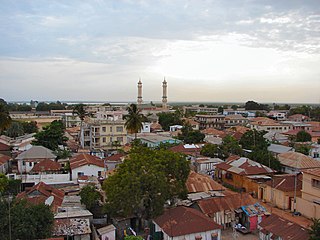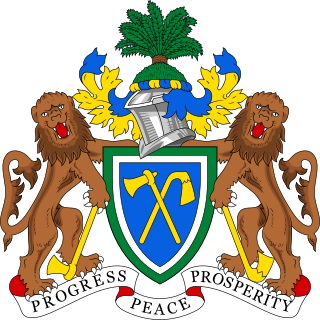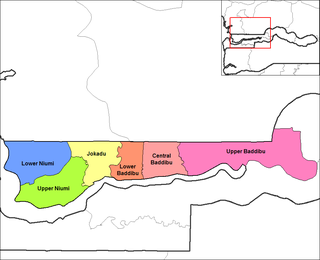
Banjul, officially the City of Banjul, is the capital and fourth largest city of The Gambia. It is the centre of the eponymous administrative division which is home to an estimated 400,000 residents, making it The Gambia's largest and most densely populated metropolitan area. Banjul is on St Mary's Island, where the Gambia River enters the Atlantic Ocean.

The Gambia is a very small and narrow African country with the border based on the Gambia River. The country is less than 48 kilometres (30 mi) wide at its greatest width. The country's present boundaries were defined in 1889 after an agreement between the United Kingdom and France. It is often claimed by Gambians that the distance of the borders from the Gambia River corresponds to the area that British naval cannon of the time could reach from the river's channel. However, there is no historical evidence to support the story, and the border was actually delineated using careful surveying methods by the Franco-British boundary commission. The Gambia is almost an enclave of Senegal and is the smallest country on mainland Africa.

The Kingdom of Saloum was a Serer/Wolof kingdom in present-day Senegal. Its kings may have been of Mandinka/Kaabu origin. The capital of Saloum was the city of Kahone. It was a sister kingdom of Sine. Their history, geography and culture were intricately linked and it was common to refer to them as the Sine-Saloum.

The Gambia River is a major river in West Africa, running 1,120 kilometres (700 mi) from the Fouta Djallon plateau in north Guinea westward through Senegal and The Gambia to the Atlantic Ocean at the city of Banjul. It is navigable for about half that length.
Alvise Cadamosto or Alvise da Ca' da Mosto was a Venetian explorer and slave trader, who was hired by the Portuguese prince Henry the Navigator and undertook two known journeys to West Africa in 1455 and 1456, accompanied by the Genoese captain Antoniotto Usodimare. Cadamosto and his companions are credited with the discovery of the Cape Verde Islands and the points along the Guinea coast, from the Gambia River to the Geba River, the greatest leap in the Henrican discoveries since 1446. Cadamosto's accounts of his journeys, including his detailed observations of West African societies, have proven invaluable to historians.

Albreda is a historic settlement in the Gambia on the north bank of the Gambia River, variously described as a 'trading post' or a 'slave fort'. It is located near Jufureh in the North Bank Division and an arch stands on the beach connecting the two places. As of 2008, it has an estimated population of 1,776.

Bakau is a town on the Atlantic coast of Gambia, west of Gambia's capital city of Banjul. It is known for its botanical gardens, its crocodile pool Bakau Kachikally and for the beaches at Cape Point. Bakau is the first major suburb outside Banjul and the most developed town in the Gambia. Close to Bakau and Banjul is Gambia's largest city, Serekunda.

Jufureh is a town in the Gambia, 30 kilometers inland on the north bank of the River Gambia in the North Bank Division near Kunta Kinteh Island. The town is home to a museum and Fort Jillifree.
Kanilai is a village in southern Gambia, near the border with Senegal. The former president of The Gambia, Yahya Jammeh, was born in this village and expanded it after coming to power. Previously, the town had been a quiet backwater, home to small-scale maize and groundnut farmers and little else. It is now home to a presidential palace, a wrestling arena, a luxury hotel and a game park and zoo. The zoo, which Jammeh said would allow Gambians to "experience African wildlife", was unsuccessful at first, with animals dying due to hunting, predation and insufficient food.
Nuno Tristão was a 15th-century Portuguese explorer and slave trader, active in the early 1440s, traditionally thought to be the first European to reach the region of Guinea. Legend has it that he sailed as far as Guinea-Bissau, however, more recent historians believe he did not go beyond the Gambia River).

North Bank was one of the five administrative divisions of the Gambia. Its capital was Kerewan. It was subsequently reorganised as the Kerewan Local Government Area (LGA), without any change in the area covered.

The Trans-Gambia Highway is a major highway in The Gambia, running across the centre of the nation in a north–south direction.

The Gambia is subdivided into 43 districts. They are listed below by Local Government Area, each with its population at the 15 April 2013 census.

Lower Niumi is one of the six districts of the North Bank Division of the Gambia. In the 2013 census, it had a population of 57,358.

Upper Niumi is one of the six districts of the North Bank Division of the Gambia which is located in West Africa The remaining five districts are: Lower Niumi, Jokadu, Lower Baddibu, Central Baddibu and Upper Baddibu.
Bakindick Mandinka is a town in western Gambia. It is located in Lower Niumi District in the North Bank Division. As of 2008, it has an estimated population of 1,801.
The Niominka people are an ethnic group in Senegal living on the islands of the Saloum River delta. They are currently classified as a subgroup of the Serer.
Essau is a small town in north-western Gambia. It is located in Lower Niumi District in the North Bank Division. As of 2009, it has an estimated population of 6,670.
The Barra War, also known as the Anglo-Niumi War or the British-Barra War, was a military conflict that lasted from 1831 to 1832 between forces of the British Empire and the Kingdom of Niumi, in what is now The Gambia.

The Kingdom of Niumi, also known as the Kingdom of Barra, was a West African nation at the Gambia River. Niumi was located at the mouth of the river, and extended nearly 60 kilometres (40 mi) along and north of its north bank. For much of its existence, its eastern border was occupied by the Kingdom of Baddibu, and its northern border was open savanna leading to Senegal. Formally becoming part of the Gambia Colony and Protectorate in 1897, the Kingdom now forms the Upper Niumi and Lower Niumi districts of the North Bank Division in The Gambia.













